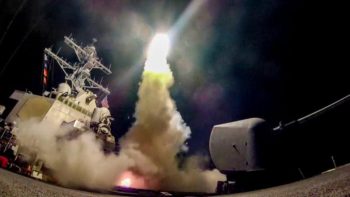
Sailing in the eastern Mediterranean, a pair of U.S. destroyers twice rehearsed firing a fusillade of million-dollar missiles toward a Syrian airbase before President Donald Trump signed the order to launch.
Three hours after the president’s “execute order” on Thursday, the USS Ross and USS Porter fired 59 Tomahawk missiles built by Raytheon Co. The destroyers were in the Eastern Mediterranean but under supervision of the commander aboard the USS George H.W. Bush aircraft carrier in the Persian Gulf.
And an hour after that, the missiles hit their targets almost simultaneously, destroying about 20 Syrian aircraft in hangars and on runways as well as petroleum storage at a base that the U.S. says President Bashar al-Assad’s regime had used to launch a deadly chemical weapon attack against civilians on April 4.
The U.S. used the latest-model Tactical Tomahawks, which can be redirected in mid-flight, transmit images to commanders and loiter over a potential target area, according to accounts by U.S. military officials who briefed reporters or spoke in interviews. They asked not to be identified discussing operational details.
“This operation is a reminder that forward-deployed U.S. Navy ships, operating from international waters, have various ways of affecting events ashore, including Tomahawk cruise missiles” that can be fired “without putting additional boots on the ground or risking pilot lives,” Ronald O’Rourke, a military naval analyst with the Congressional Research Service, said in an email.
The fusillade of Tomahawks aimed at the Shayrat airfield was one of the options prepared by U.S. Central Command in about a day after Trump condemned the April 4 gas attack, on the assumption the White House might want to act fast to back up the president’s implied threat, one of the officials said. That proved correct when the administration formally requested that the Pentagon ready alternatives.
Once Trump gave the go-ahead order for the Tomahawk strike, the operation moved at a rapid pace. Shortly after 4:35 p.m. New York time on Thursday, Army General Joseph Votel, the head of Central Command, received a call from Marine Corps General Joe Dunford, chairman of the Joint Chiefs of Staff, telling him to execute the attack. Votel, who was at an event on the U.S. East Coast, passed the order on via a secure video link even before the White House’s written authorization, according to one of the officials.
The 59 missiles launched — a 60th malfunctioned — hit an equal number of targets at the Shayrat air field, which one of the military officials said had been associated with Syrian government chemical attacks since 2013.
The U.S. notified the Russian military in Syria before the attack because it had personnel and helicopters at the base in a separate area that the Tomahawks didn’t hit. One of the U.S. officials said the Pentagon had no intelligence indicating that the Russians tipped off Syria to the looming attack.
The Trump administration has described the attack as “proportionate.” An example cited by defense officials: Runways at the airbase weren’t cratered to make them unusable.
The 59 Tomahawks fired was modest compared with the 288 launched when the missile was first used in the Persian Gulf War in 1991. About 725 were fired at Iraqi targets at the start of the 2003 U.S. invasion of Iraq, according to a compilation by Byron Callan, defense analyst for Capital Alpha Partners LLC.
The Navy says it’s buying the last 100 Tomahawks this year before ending production in favour of upgrades to the inventory and starting development on a successor “Next Generation Land Attack Weapon.”